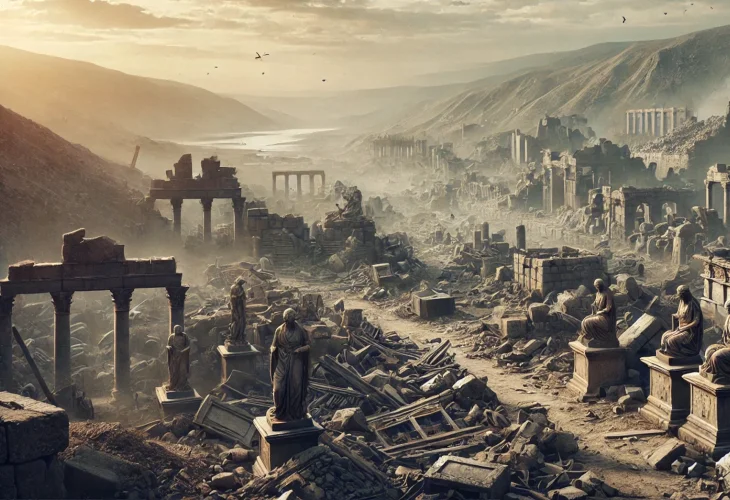From Fortified City to Ruins: The Archaeological Secrets of Hazor
In 13th century Hazor, shortly after Joshua's entry into the land, a layer of destruction reveals a city burned, statues shattered, and buried under three meters of ash and ruin.

Hazor is a thriving development town in the north, on the way to Metula. Once this war ends, God willing, we will always, always stop at the refreshment station in Hazor... But three and a half millennia ago, a vast and fortified city named Hazor lay not in the north, but centered west of Lod. Hazor held a significant place during the early centuries of Israel's settling in their land.
The land of Israel is steeped in history. The map of the land is dotted with excavations and archaeological sites, seeking history within the earth. Each site has several layers, each one a remnant of a different era of the city. One such era is the Canaanite period.
Among all the sites from the Canaanite period, one stands above the rest, Tel Hazor. The city of Hazor was the most significant, largest, and central city in Canaan. How large? It spanned about 840 dunams! For comparison, the city of Lachish, also important, covered no more than 50 dunams, and Megiddo, another fortified city, didn't exceed 60 dunams. Tel Hazor is the largest biblical site among all the biblical sites in the land.
The archaeological findings from Tel Hazor precisely match the city's description in the Tanach. The book of Joshua describes Hazor's stature in the Canaanite realm as: "Head of all those kingdoms," and indeed, the archaeological findings confirm Hazor's elevated status.
During the Canaanite period, before the Exodus from Egypt, Canaan was under Egyptian control, and its city-states paid tribute to Egypt and had regular correspondence. In these letters, the Egyptians referred to no other Canaanite ruler as "King" except for the king of Hazor.
Not only did the Egyptians acknowledge the rule of Hazor's leader, but they also sent gifts to the king of Hazor, an unusual act since Egypt at that time was the most important and powerful kingdom in the world. All kings sought Pharaoh's favor, hence gifts were sent to him, not the other way around.
Excavations in Hazor revealed lavish palaces, temples, and many monumental structures, as well as extensive correspondence with all the major cities of their time.
The Destruction of Hazor
The entry of the Israelites into the land and Joshua's conquests occurred in the 13th century BCE. The book of Joshua narrates how the king of Hazor led a regional coalition to fight Israel: "Now when Jabin king of Hazor heard, he sent to Jobab king of Madon, the king of Shimron, and the king of Akshaph... And they came out with all their armies, a people numerous as the sand on the seashore in multitude, with very many horses and chariots."
The book of Joshua describes Joshua's victory over the coalition, burning their chariots, and the fate of Hazor as follows: "At that time Joshua turned back, captured Hazor, struck its king with the sword, because Hazor previously had been the head of all these kingdoms. They struck all the people there with the sword, utterly destroying them, leaving no soul; and Hazor was burned with fire."
What are the findings?
In 13th century Hazor, shortly after Joshua's entry into the land, there is a layer of destruction where the whole city was burned, all statues and monuments shattered, and the city buried under a three-meter-thick layer of ash and ruin.
Some archaeologists are baffled by the findings. Who destroyed the city of Hazor? Egypt was their ally and the Babylonians were not influential at the time. No known power could have destroyed the great and mighty city of Hazor. They argue that the Israelites could not have destroyed Hazor, believing that the Israelites were a "late invention"... Some speculate about an internal revolt within the city. This is dismissed for two reasons.
- Revolts didn't exist then. Ordinary citizens did not become kings. Occasionally, a military officer or a relative of the king might seize power, but revolts by the populace didn't happen.
- Even if a revolt occurred, why burn the city? Whoever seized control would simply rule.
The Reconstruction of Hazor
After Hazor's destruction, the city was inhabited only on a small fraction of its original area until the days of King Solomon. The Book of Kings details Solomon's extensive building projects throughout the land, including the reconstruction of Hazor, Megiddo, and Gezer. As described in the Book of Kings: "Here is the account of the forced labor King Solomon conscripted to build... Hazor, Megiddo, and Gezer."
In the 1950s and 1960s, archaeologist Yigal Yadin excavated Hazor, Megiddo, and Gezer. In the gates of these three cities, he found similar gates with uniform fortress structures. Yadin dated the construction of these gates to the time of King Solomon, or in archaeological terms, "Early Iron Age I."
Tel Hazor provides further evidence that archaeology does not contradict the Tanach; when interpreted correctly, archaeological findings can expand our knowledge of the period and reveal wonderful things not explained in the Tanach.

